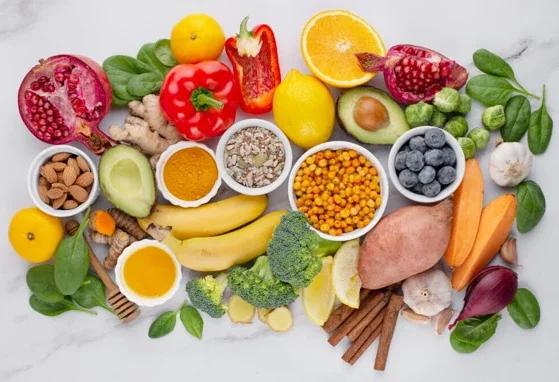What are Discretionary Calories and Do they Matter – Especially Now?
It seems, often, that much information about nutrition and health gets lost in translation. From scientific research papers to nutrition experts, much of what is said about calories and nutrition needs and healthy diet, obesity and malnutrition gets lost as it trickles down to the average consumer.
With that in mind, let’s talk “discretionary calories”.
The term seems confusing. Is a calorie not just a calorie? Do we all get these calories, and if we do, what do we do with them? Are they important? And what do we mean by ‘discretion’ - particularly when it comes to nutrition?
It’s time to break it down.
Every human being, from birth the death, has a nutrient requirement that must be met in order to grow, develop and thrive. Our required calorie count changes as we grow and depends on our levels of activity. How we usually eat, how many calories we consume, will be different during lockdown than when we are able to be active.
Exactly what is a Calorie?
Most of our clients have heard about calories. They may be counting calories or balancing calories but does the average person really understand what a calorie is?
Simply put, a calorie is a unit of energy. According to The Nutrition Society of South Africa, calories refer to the energy people get from the food and drink they consume, and the energy they use in physical activity. Bodies need calories for energy but eating too many calories — and not burning enough of them off — can lead to weight gain.
Many clients find it difficult to calculate the calories they consume. It is hard for many, younger clients especially, to understand that the same physical amount of food is not equal in terms of the energy it provides. For example: 1 cup of shredded lettuce has less than 10 calories, whereas a cup of peanuts has over 800 calories.
The average woman needs to eat about 2 000 calories per day to maintain her weight, and the average man needs 2 500 calories per day.
What is a Discretionary Calorie?
Discretionary calories are the calories that are ‘left over’ after meeting nutrient requirements from the healthy foods you eat, about 10% of calories. These ‘left overs’ are often ‘empty calories’ – foods that are high in fats and added sugars but that lack nutritional value like vitamins, minerals, antioxidants, protein, and fibre.
These ‘empty calories’ are major contributors to obesity. Foods like ice-cream, pies and pastries, bacon, pizza, fruit juice and colddrinks, energy drinks, as well as alcohol are high in added sugar and fat. The Centers for Disease Control and Prevention (CDC) found that more than 11% of calories consumed by Americans come from fast foods. According to registered dietitian, Joan Knoll, about 40% of calories children consume are from ‘discretionary’ foods and beverages that lack nutrients needed for healthy growth. According to an Australian government report, some foods and drinks do not fit into the Five Food Groups because they are not necessary for a healthy diet. “The problem is that they can take the place of other more nutritious foods,” said the report. The CDC and WHO point out that food high in kilojoules, saturated fat, added sugars, and added salt are associated with increased risk of obesity and chronic disease such as heart disease, stroke, type 2 diabetes, and some forms of cancer.
What do we mean by ‘Discretion’?
According to the Merriam-Webster online dictionary, discretion can be defined as the “ability to make responsible decisions”. Believe it or not, we make over 200 food-related decisions per day. That gives us a lot of room for error.
Researcher Brian Wansink, says that "The best diet is the one you don't know you're on." He says that most people make bad or irresponsible food decisions, or are tricked into these decisions by not really understanding food labels and nutrition terms. “Guessing how many calories we ate in a meal is a dangerous game. Most of us terribly underestimate how much we eat - usually by up to 50%.”
Getting the balance right
According to the International Food Information Council, many of us exhaust our potential discretionary calories before we’ve met our nutrient needs. The junk food, fast food trap is one that is easy to fall into.
When it comes down to it, discretionary calories are a privilege, not a right.
A good way to explain this balance of calories, energy, weight and discretion to your patients/clients is this:
“Think of the calories you need like money you have to spend. Each of us has a “calorie budget’. This budget can be divided into the ‘essentials’ (the things we must have) and the ‘extras’ (the things we would like to have).
Every person has an essential minimum number of calories to meet our nutrient needs. If we choose wisely, and invest in nutrient-dense, healthy foods that are low in fat and have no added sugar, we may have a few calories left over. These are our discretionary calories.
However, just like our bank accounts that seldom have as much in them as we hope, most discretionary calorie allowances are small - between 100 and 300 calories, and less for people who are not physically active.
The Institute of Medicine cautions that many people use their daily allowance even before lunch. While discretionary calories can be used on ‘luxuries’, for many people they are used in regular meal choices – like fatty meats, whole milk, or sweetened bakery products.
Healthcare professionals understand all of these issues and must be able to communicate them, in simple terms, to clients.
Discretionary Calories in the time of COVID-19
With national shutdown in place all over the world, people have been forced to cook and eat at home.
There are many issues when it comes to nutrition, and not all family members are create alike. While one member of a family can tolerate sugar and diary, another cannot. This makes shopping and cooking more of a challenge, especially now during shutdown.
Many of your clients are used to making ‘fast food’ decisions. We are all bombarded with highly processed fast foods that offer quick food-on-the-run solutions. Now, we don’t have that option. Many people, the world over, are so used to making faulty food decisions that the habit is hard to break.
However, just because you eat at home, doesn’t mean you’re eating healthy. Your clients (and everyone else) need your guidance now more than ever.
Our best and worst eating habits start in the grocery store. How many of your clients wonder around and just pull things into a trolley? Or head straight for the middle isles where the boxed food options are?
Remind your clients that:
- The further inside a store you go, the more boxed-food you find
- If food comes in a box, it more processed and less healthy
- Stick rather to the outside aisles - fresh fruit and vegetables, no fat dairy.
A lot of people ‘co-eat’. We nibble when we watch TV, snack while we work, open the fridge every time we head into the kitchen, munch while we read… The fact that we are all house-bound is making this a lot worse. Research conducted at Cornell University revealed that you are 3 times more likely to eat the first food that you see. The same study also showed that we are 72% more likely not to eat the ‘bad snack’ when it is hard to see and hard to reach.
Some advice:
- Replace the ‘bad snacks’ with pre-cut fresh vegetables like carrots, celery and snap peas
- Replace salty fried chips with fresh popcorn
- If there is something that is in your cupboard that only you have an issue with – hide it – out of sight, out of reach
Guessing how many calories we ate is a recipe for disaster. In research published in the Journal of Marketing Research, Pierre Chandon and Brian Wansink found that people underestimate how much they have consumed by up to 50%. They found that the bigger the meal, the less accurate people were in ‘estimating’ calories.
Some advice for clients:
If you really can’t have a definite number, rather estimate what each food item cost in terms of calories – so instead of guessing the whole meal, break it down: what did the juice count for, the rice, the carrots, the meat, the bread and then add all those numbers up. “We’re a lot more accurate when we estimate small amounts of food than entire meals,” says Wansink.
In conclusion, use discretionary calories very wisely.
If you liked this post you may also like




